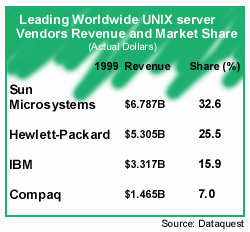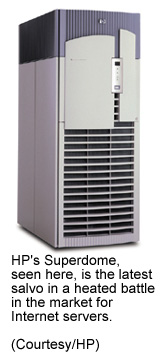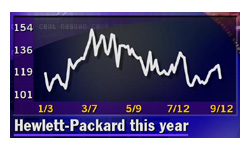|
HP rolls out 'Super' server
|
 |
September 12, 2000: 4:23 p.m. ET
'Superdome' system supports multiple platforms, targets dot.coms
By Staff Writer Richard Richtmyer
|
NEW YORK (CNNfn) - Hewlett-Packard Co. on Tuesday unveiled the latest weapon in the ongoing battle for market share among the top suppliers of computer systems for Internet-based businesses.
The company rolled out its much-anticipated HP 9000 Superdome server, which is the most powerful of such systems in HP's product line. Executives are aiming the new servers at large dot.coms, service providers and other data-intensive environments.
Under the stewardship of Carly Fiorina, who took the helm as the Palo Alto, Calif.-based company's chief executive last summer, HP has sharpened its focus on the market for Web servers.
But while the company has made strides on the low end, it has not had as much success at the top of the market. When it reported its fiscal third-quarter earnings in mid-August, HP (HWP: Research, Estimates) said revenue from its low-end servers had risen 117 percent, while high-end server sales had risen only modestly.
That was a disappointment to some analysts, and the stock dropped sharply as a result.
"It is on the high end where we've been lagging," Fiorina told a group of about 500 gathered in lower Manhattan for the launch event Tuesday. "But today, just like we've changed the game in the low end, we will change the game in the high end."
 The Superdome introduction is the latest salvo in HP's server battle with Sun Microsystems, currently the market leader, and IBM, which is running third. HP is running second in the server market, according to technology research firm Dataquest. The Superdome introduction is the latest salvo in HP's server battle with Sun Microsystems, currently the market leader, and IBM, which is running third. HP is running second in the server market, according to technology research firm Dataquest.
For its part, Sun (SUNW: Research, Estimates) has been having a lot of success with its high-end E10000 Starfire servers, which are powered by its UltraSparc II microprocessors. The company is expected to release its long-delayed UltraSparc III processors in the next few weeks. Those chips had been expected to hit the market at the end of 1999.
Meanwhile, IBM (IBM: Research, Estimates) has been making headway with its RS/6000 S80, the flagship of its server line. Those systems, as well as the mid-price range RS/6000 servers, use semiconductors that are built using copper interconnects, allowing more processing power in a smaller package.
IBM on Monday announced that it had transferred some of its supercomputing technology over to its S80 servers in order to make them easier to manage and increase their reliability.
 With the new Superdome system, which executives said is priced starting at about $400,000 and will start shipping in volume in December, HP said it is raising the bar in the server market. With the new Superdome system, which executives said is priced starting at about $400,000 and will start shipping in volume in December, HP said it is raising the bar in the server market.
"On a pure technology basis, we are leapfrogging our competition in terms of processing performance and compute power, both in terms of the number of CPUs customers can order as well as in the performance of the processors themselves," Fiorina said.
The Superdome system currently is available with as many as 32 PA-8600 microprocessors operating at 552MHz and as much as 256 gigahertz of memory. The company also said it has been designed to enable users to easily upgrade it to the 64-bit Itanium processors HP is co-designing with Intel.
That kind of flexibility sharply differentiates HP from its competitors, according to Duane Zitzner, president of the company's computing systems unit.
"To upgrade to IA 64, all you have to do is replace a cell board in the product," Zitzner said. "With IBM, you're going to have to switch systems, and with Sun, you're going to have to switch vendors."
The system also enables users to upgrade and swap out other components on the fly without bringing the entire system down, Zitzner said.
In addition to the higher performance, Superdome has been designed to support multiple computer operating systems simultaneously, including Unix, Microsoft's Windows NT and the freely distributed Linux operating system.
"Technology is changing so fast, that to bet a business on a proprietary technology, or on a single technology, commits an IT environment to becoming a legacy environment," Fiorina said.
HP also has revamped its server sales force, with the hardware sales representatives working more closely with the services sales representatives and each of them working in coordination with a "solutions manager" who sees the sales through from the initial discussions through the installation of the system. The solutions manager will then hand off responsibility to a support manager.
The Superdome also will be available with a new "utility-based" pricing system under which customers pay only for the computing power and capacity they need and can add power as their needs grow, HP said.
Analysts guardedly optimistic
Although the Superdome was rolled out with much fanfare and HP executives effectively threw down the gauntlet in their ongoing battle with Sun and IBM, industry observers weren't quite ready to cheer too loudly after the announcement.
"It's a good start," said Thomas Wang, technology analyst at Morgan Stanley, who noted that the move toward an open architecture is one of the key strengths of the new system.
"One of the big trends these days is the move toward open standards computing and a lot of people have that gripe about Sun, that they're sort of locked in," Wang said. "HP is now countering that by making multiple platforms available."
Andrew Neff of Bear Stearns said that he's excited about what he saw at the product launch but pointed out that HP still has some ground to cover when it comes to winning back customer confidence.
"It's not Hewlett versus Sun. They're not there yet," Neff said. "I think it's Hewlett versus Hewlett today. They have to convince their customers that they're back in the game."
 The company said it already has 150 customers "in the funnel," and 16 of the Superdome systems already have been installed at customer sites. Among these are Internet retailing giant Amazon.com, which is currently evaluating the Superdome system; First Union, which plans to use it in certain areas of its banking business; and European IT services provider debis IT Services, which also is evaluating the system, HP said. The company said it already has 150 customers "in the funnel," and 16 of the Superdome systems already have been installed at customer sites. Among these are Internet retailing giant Amazon.com, which is currently evaluating the Superdome system; First Union, which plans to use it in certain areas of its banking business; and European IT services provider debis IT Services, which also is evaluating the system, HP said.
Even so, HP executives said they don't expect the new servers to begin having a material impact on earnings and profit margins until the first fiscal quarter, which begins in January.
HP shares fell $1.50 to $112.50 on the New York Stock Exchange Tuesday. But market watchers attributed that slide to mounting concerns about the company's plans to acquire the consulting arm of PricewaterhouseCoopers.
On Monday, HP confirmed that it was considering buying the PricewaterhouseCoopers unit for as much as $18 billion.
Credit rating agency Standard & Poor's on Tuesday said it has put the ratings for all of HP's debt under review and indicated that it would possibly downgrade it if the deal is consummated because of the expenses that would be associated with such a transaction. 
|
|
|
|
|
 |

|

